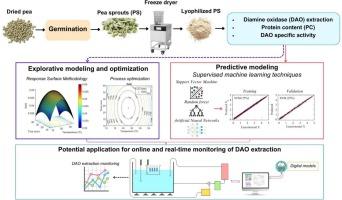Multivariate statistical optimization of the ultrasonic-assisted extraction of diamine oxidase (DAO) from pea sprout
IF 9.7
1区 化学
Q1 ACOUSTICS
引用次数: 0
Abstract
Pea sprouts can provide a plant-based alternative to the commonly used pork kidney as a source of diamine oxidase (DAO), an enzyme used as a dietary supplement to prevent symptoms of histamine intolerance. This study assessed the influence of process variables on the ultrasonic-assisted extraction of DAO from pea sprouts. DAO activity (DAOac), protein content (PC), and their ratio (DAOsac) were measured on extracts obtained at different times (10, 20, 30, 40 min), temperatures (10, 20, 37 °C), and acoustic pressures (0, 29, 75 kPa). Response surface methodology (RSM) and multivariate regression models were applied to identify the optimal conditions and predictive multivariate models were assessed to develop a process control tool. Ultrasound application significantly enhanced DAO extraction, increasing DAOac, PC, and DAOsac by up to 34.4, 14.9, and 19.4 % compared to conventional methods. The application of a moderate acoustic pressure (29 kPa) maximized yields, while a higher one (75 kPa) reduced extraction time. The moderate optimal temperature identified, 23.0 ± 0.3 °C, represents a clear advantage for the process scaling-up. The Support Vector Machine (SVM) model showed the best predictive performance (adjusted coefficient of determination; R2adj > 92 % and mean relative error; MRE < 4 %), accurately estimating dependent variables based on process conditions. Therefore, this model could support the implementation of a closed-loop control strategy, dynamically adjusting operational parameters to maintain the extraction process under optimal conditions.

超声辅助提取豌豆芽中二胺氧化酶(DAO)的多元统计优化。
豌豆芽可以替代常用的猪肾作为二胺氧化酶(DAO)的来源,二胺氧化酶是一种用于预防组胺不耐受症状的膳食补充剂。研究了不同工艺条件对超声辅助提取豌豆芽中DAO的影响。在不同时间(10、20、30、40 min)、温度(10、20、37℃)和声压(0、29、75 kPa)下提取的提取物中,测定DAO活性(DAOac)、蛋白质含量(PC)及其比值(DAOsac)。采用响应面法(RSM)和多元回归模型确定最佳工艺条件,并对多元预测模型进行评估,开发工艺控制工具。超声应用显著增强了DAO的提取,与常规方法相比,DAOac、PC和DAOsac分别提高了34.4%、14.9%和19.4%。应用中等声压(29 kPa)可使产量最大化,而较高声压(75 kPa)可缩短提取时间。确定的中等最佳温度为23.0±0.3°C,对于工艺放大具有明显的优势。支持向量机(SVM)模型的预测效果最好(调整后的决定系数,平均相对误差为92%)
本文章由计算机程序翻译,如有差异,请以英文原文为准。
求助全文
约1分钟内获得全文
求助全文
来源期刊

Ultrasonics Sonochemistry
化学-化学综合
CiteScore
15.80
自引率
11.90%
发文量
361
审稿时长
59 days
期刊介绍:
Ultrasonics Sonochemistry stands as a premier international journal dedicated to the publication of high-quality research articles primarily focusing on chemical reactions and reactors induced by ultrasonic waves, known as sonochemistry. Beyond chemical reactions, the journal also welcomes contributions related to cavitation-induced events and processing, including sonoluminescence, and the transformation of materials on chemical, physical, and biological levels.
Since its inception in 1994, Ultrasonics Sonochemistry has consistently maintained a top ranking in the "Acoustics" category, reflecting its esteemed reputation in the field. The journal publishes exceptional papers covering various areas of ultrasonics and sonochemistry. Its contributions are highly regarded by both academia and industry stakeholders, demonstrating its relevance and impact in advancing research and innovation.
 求助内容:
求助内容: 应助结果提醒方式:
应助结果提醒方式:


